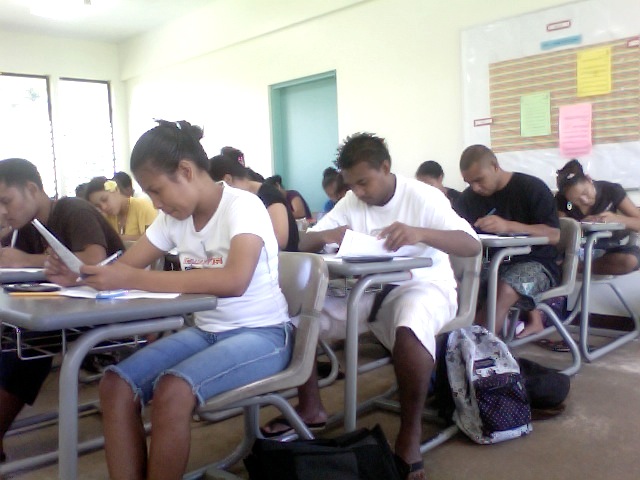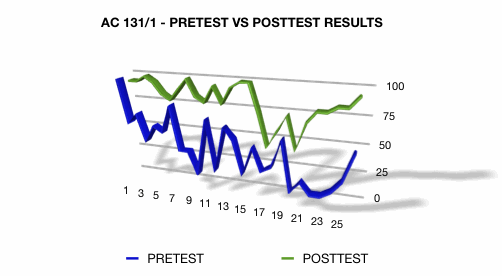Assessment / Fall 2010 > AC 131/1 - ACCOUNTING 1
PRETEST VS POSTTEST
These assessment data are for AC 131/1 - ACCOUNTING 1, Section 1 in the Fall Semester 2010.
Twenty-six students were registered in this class. The number of students who took the pretests were fewer than those who took the posttests, because pretests were given on the first day of instruction during which the add/drop period was in effect. Students who took the pretest but eventually dropped out of the course or withdrew from the class were also excluded in the analysis.BACKGROUND
Starting this Fall 2010, AC 131 was offered as a four-credit course, with six lecture and lecture-lab hours per week. The change in number of credits and contact hours was the result of previous assessments at the course and program levels, which revealed a need to expose and actively engage students in more intensive problem-solving activities to more effectively achieve desired learning outcomes.
With the change in credits and teaching hours, this instructor was able to exercise maximum flexiblity in implementing a variety of teaching strategies, assign more problem materials in class, and stayed on track with the course requirements as outlined in the syllabus. There was also greater ease in conducting lectures/discussions in smaller chunks, limiting them to a few 10-15 minutes at a time, followed by longer periods of deeply absorbing and engaging problem-solving activities.
ITEM ANALYSIS
The table below shows a comparison of the results in the first part of the pretest, of which 26 questions were embedded in the midterm exam (posttest 1). See item analysis sheets (PRETEST, POSTTEST1, COMPARATIVE DATA) for details.
| PRETEST-POSTTEST 1 | ||||||
| ASSESSMENT | PRETEST (20 students) | POSTTEST (20 students) | INCREASE (DECREASE) | |||
| ITEM # | NUMBER OF STUDENTS WITH CORRECT ANSWERS | PERCENT | NUMBER OF STUDENTS WITH CORRECT ANSWERS | PERCENT | ||
| 1 | 20 | 100% | 19 | 95% | (5%) | |
| 2 | 12 | 60% | 19 | 95% | 35% | |
| 3 | 14 | 70% | 20 | 100% | 30% | |
| 4 | 9 | 45% | 19 | 95% | 50% | |
| 5 | 12 | 60% | 17 | 85% | 25% | |
| 6 | 11 | 55% | 16 | 80% | 25% | |
| 7 | 16 | 80% | 18 | 90% | 10% | |
| 8 | 8 | 40% | 20 | 100% | 60% | |
| 9 | 8 | 40% | 17 | 85% | 45% | |
| 10 | 4 | 20% | 16 | 80% | 60% | |
| 11 | 14 | 70% | 19 | 95% | 25% | |
| 12 | 5 | 25% | 16 | 80% | 55% | |
| 13 | 13 | 65% | 19 | 95% | 30% | |
| 14 | 11 | 55% | 20 | 100% | 45% | |
| 15 | 5 | 25% | 20 | 100% | 75% | |
| 16 | 10 | 50% | 15 | 75% | 25% | |
| 17 | 6 | 30% | 9 | 45% | 15% | |
| 18 | 7 | 35% | 12 | 60% | 25% | |
| 19 | 12 | 60% | 15 | 75% | 15% | |
| 20 | 3 | 15% | 9 | 45% | 30% | |
| 21 | 5 | 20% | 14 | 70% | 50% | |
| 22 | 3 | 15% | 16 | 80% | 65% | |
| 23 | 3 | 15% | 16 | 80% | 65% | |
| 24 | 4 | 20% | 17 | 85% | 65% | |
| 25 | 6 | 30% | 17 | 85% | 55% | |
| 26 | 11 | 55% | 19 | 95% | 40% | |
| AVERAGE | 8.92 | 45% | 16.69 | 83% | 38% | |
TEST COVERAGE There were 45 multiple choice questions in the pretest. Of these, 26 were embedded in the midterm exam, which served as posttest 1. The remaining 19 questions will be embedded in the final exam (posttest 2). The 26 questions were linked to the following SLOs.
DISCUSSION OF RESULTS As expected, the pretest yielded very low results, with some questions answered correctly by three students only, or 15%. The average for the group, made up of 20 students, was 45%. The results of the posttest (for the same group of students) showed an encouraging 83%, or a 38% increase over the pretest. This is clear proof that learning had taken place during the first half of the semester, and that intended student learning outcomes had been achieved. Results for all items except that of No. 1 showed positive changes. Two items with with increases but low results are noted below. ITEM 17 tested the student's knowledge of what information can be found in the chart of accounts. In the posttest, only nine of 20 students, or 45%, answered the question correctly. [SLO 2.1] ITEM 20 tested the student's knowledge, understanding and skill in analyzing and calculating the expired portion of a prepaid insurance and giving the required adjusting journal entry. In the posttest, only nine (or 45%) of the students answered the question correctly. [SLO 2.3] ITEM 1, which tested the student's knowledge of the three types of business operations by identifying a merchandising business from a list of companies, showed unusual results (100% in the pretest, versus 95% in the posttest, or a decrease of 5%!) [SLO 1.1] CHART OF TEST RESULTS The chart below which plots the pretest and posttest results in the table shown above clearly demonstrates in graphic format the extent of learning that had taken place between August 13, 2010 when the pretest was given, and October 1, 2010 when the posttest was administered. |
||||||
Compare results with Section 2


